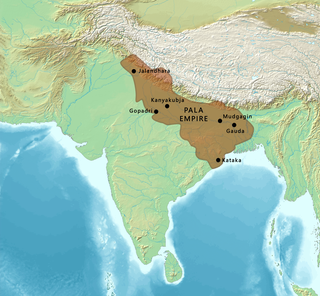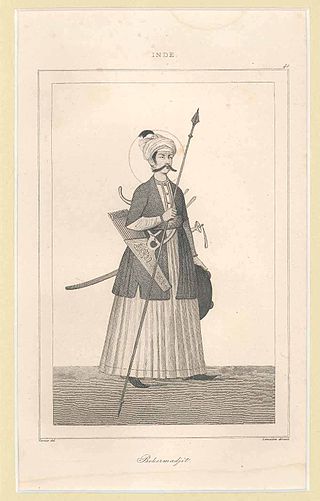
The Magadhan Empire was an ancient Indian empire that succeeded the Magadha Mahajanapada. It was established by Bimbisara in 544 BC. It was ruled by the Haryankas, the Shaishunagas, the Nandas, the Mauryas, the Śungas, the Kanvas.

Chandragupta Maurya was the founder of the Maurya Empire, which ruled over a geographically-extensive empire based in Magadha. He reigned from 320 BCE to 298 BCE. The Magadha kingdom expanded to become an empire that reached its peak under the reign of his grandson, Ashoka the Great, from 268 BCE to 231 BCE. The nature of the political formation that existed in Chandragupta's time is not certain. The Mauryan empire was a loose-knit one with large autonomous regions within its limits.
The Gupta Empire was an ancient Indian empire on the Indian subcontinent which existed from the mid 3rd century CE to mid 6th century CE. It was the seventh ruling dynasty of Magadha. At its zenith, from approximately 319 to 467 CE, it covered much of the Indian subcontinent. This period has been considered as the Golden Age of India by historians, although this characterisation has been disputed by some other historians. The ruling dynasty of the empire was founded by Gupta and the most notable rulers of the dynasty were Chandragupta I, Samudragupta, Chandragupta II, Kumaragupta I and Skandagupta.

Chandragupta II, also known by his title Vikramaditya, as well as Chandragupta Vikramaditya, was the third ruler of the Gupta Empire in India. Modern scholars generally identify him with King Chandra of the Delhi iron pillar inscription.

Chandragupta I was a monarch of the Gupta Empire, who ruled in northern and central India. His title Mahārājadhirāja suggests that he was the first suzerain ruler of the dynasty. It is not certain how he turned his small ancestral kingdom into an empire, although a widely accepted theory among modern historians is that his marriage to the Licchavi princess Kumaradevi helped him extend his political power. Their son Samudragupta further expanded the Gupta Empire.

Gupta was the founder of the Gupta dynasty of northern India and ruler of the Principality of Pataliputra. He is identified with king Che-li-ki-to, who, according to the 7th-century Chinese Buddhist monk Yijing, built a temple near Mi-li-kia-si-kia-po-no (Mṛgaśikhāvana) for Chinese pilgrims.

Magadha was an ancient Indo-Aryan kingdom and one of the sixteen Mahajanapadas during the Second Urbanization period, based in the eastern Ganges Plain, in ancient India. Magadha played an important role in the development of Jainism and Buddhism.

The Maurya Empire was a geographically extensive Iron Age historical power in South Asia based in Magadha. Founded by Chandragupta Maurya in 322 BCE, it existed in loose-knit fashion until 185 BCE. The empire first spread to the eastern Indo-Gangetic Plain; its capital city was located at Pataliputra. Outside this imperial centre, the empire's geographical extent was dependent on the loyalty of military commanders who controlled the armed cities scattered within it. During the rule of Chandragupta's grandson, Ashoka, the empire briefly controlled the major urban hubs and arteries of the subcontinent excepting the deep south. The primary sources for the written records of the Mauryan times are: the Arthashastra, a work previously attributed to Kautilya, but now thought to be composed by multiple authors in the first centuries of the common era; partial records of the lost history of Megasthenes in Roman texts of several centuries later; and the Edicts of Ashoka, which were first read in the modern era by James Prinsep after he had deciphered the Brahmi and Kharoshthi scripts in 1838.

The Shishunaga dynasty was the second ruling dynasty of Magadhan Empire, an empire in ancient India. According to the Hindu Puranas, this dynasty was the second ruling dynasty of Magadha, succeeding Nagadashaka of the Haryanka dynasty.
The Shunga dynasty was the fifth ruling dynasty of Magadha and controlled most of the northern Indian subcontinent from around 187 to 75 BCE. The dynasty was established by Pushyamitra, after taking the throne of Magadha from the Mauryas. The Shunga empire's capital was Pataliputra, but later emperors such as Bhagabhadra also held court at Besnagar in eastern Malwa. This dynasty is also responsible for successfully fighting and resisting the Greeks in Shunga–Greek War.

The Kanva dynasty or Kanvavamsha was the sixth ruling dynasty of Magadhan Empire, established after Vasudeva Kanva overthrew the preceding Shunga dynasty and ruled from 73 BCE to 28 BCE.

The Pāla Empire was an imperial power during the post-classical period in the Indian subcontinent, which originated in the region of Bengal. It is named after its ruling dynasty, whose rulers bore names ending with the suffix Pāla. The empire was founded with the election of Gopāla as the emperor of Gauda in late eighth century CE. The Pala stronghold was located in Bengal and eastern Bihar, which included the major cities of Gauḍa, Vikramapura, Pāṭaliputra, Monghyr, Somapura, Ramavati (Varendra), Tāmralipta and Jagaddala.

Vikramaditya was a legendary king as mentioned in ancient Indian literature, featuring in traditional stories including those in Vetala Panchavimshati and Singhasan Battisi. Many describe him as ruler with his capital at Ujjain. "Vikramaditya" was also a common title adopted by several monarchs in ancient and medieval India, and the Vikramaditya legends may be embellished accounts of different kings. According to popular tradition, Vikramaditya began the Vikrama Samvat era in 57 BCE after defeating the Shakas, and those who believe that he is based on a historical figure place him around the first century BCE. However, this era is identified as "Vikrama Samvat" after the ninth century CE.

Dhana Nanda, according to the Buddhist text Mahabodhivamsa, was the last Nanda king of Magadha.
There are conflicting theories regarding the original homeland and ancestry of the Gupta dynasty that ruled northern India between 4th and 6th centuries. Modern historians variously theorize that it originated in present-day Uttar Pradesh or Bengal, based on epigraphic, numismatic and literary evidence. The social group (varna) of the dynasty is also a matter of debate, with scholars variously placing them in Vaishya, Brahmana, or other categories.

The Nanda–Mauryan War was a war fought in ancient India from c. 323 BCE to 321 BCE between the King Dhana Nanda of the Nanda dynasty and forces of Chandragupta Maurya that led to the establishment of the Maurya Empire in Magadha. Little is known from historical sources for certain dating about the conflict. According to Mudrarakshasa legends, Chandragupta's army included Bahlika, Kirata, Parasika, Kamboja, Saka, and Greek mercenaries. The army invaded capital city Pataliputra (Kusumapura) after regaining power and defeated the Nandas.
Mi-li-kia-si-kia-po-no, believed to be a Chinese transcription of Mṛgaśikhāvana (Mriga-shikha-vana), was the site of a Buddhist establishment in eastern India. It is mentioned in the writings of the Chinese traveler Yijing, who states that king Che-li-ki-to had constructed a temple for Chinese Buddhist pilgrims near it.

Udayin also known as Udayabhadra was a king of Magadha in ancient India. According to the Buddhist and Jain accounts, he was the son and successor of the Haryanka king Ajatashatru. Udayin laid the foundation of the city of Pataliputra at the confluence of two rivers, the Son and the Ganges. He shifted his capital from Rajagriha to Pataliputra due to the latter's central location in the empire.

The Gadhwa Stone Inscriptions, or Garhwa Stone Inscriptions, are early 5th-century CE Sanskrit inscriptions discovered in Uttar Pradesh relating to a series of charitable donations to various sattra (almshouses) by Gupta Empire rulers Chandragupta II and Kumaragupta I. The inscription is notable for including symbols for numerals "8, 10, 80 and 90" in the 5th-century, as well as mentioning the ancient city of Pataliputra.












